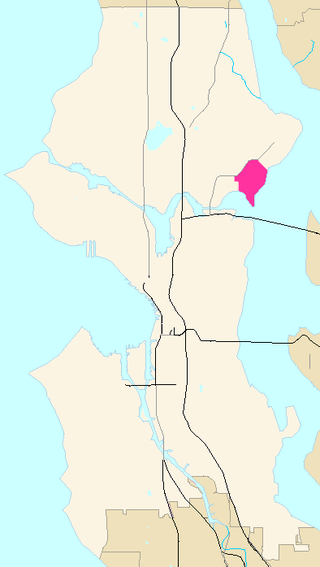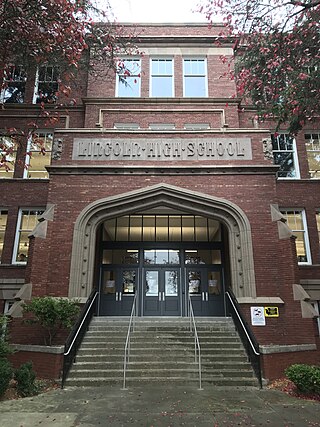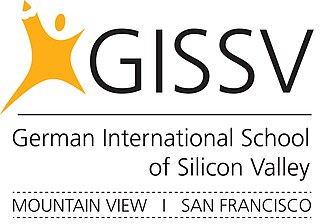
The Century 21 Exposition was a world's fair held April 21, 1962, to October 21, 1962, in Seattle, Washington, United States. Nearly 10 million people attended the fair during its six-month run.

Montrose is an area located in west-central Houston, Texas, United States and is one of the city's major cultural areas. Montrose is a 7.5 square miles (19 km2) area roughly bounded by Interstate 69/U.S. Highway 59 to the south, Allen Parkway to the north, South Shepherd Drive to the west, and Taft to Fairview to Bagby to Highway 59 to Main to the east. Montrose neighborhoods include Cherryhurst, Courtlandt Place, Hyde Park, Montrose, Vermont Commons, North and East Montrose, Mandell Place and Winlow Place. Montrose is also less well known by the moniker Neartown, encompassing Superneighborhood #24.

The Seattle Center is an entertainment, education, tourism and performing arts center located in the Lower Queen Anne neighborhood of Seattle, Washington, United States. Constructed for the 1962 World's Fair, the Seattle Center's landmark feature is the 605 ft (184 m) Space Needle, an official city landmark and globally recognized symbol of Seattle's skyline. Other notable attractions include the Pacific Science Center, Climate Pledge Arena, and the Museum of Pop Culture (MoPOP), as well as McCaw Hall, which hosts both the Seattle Opera and Pacific Northwest Ballet. The Seattle Center Monorail provides regular public transit service between the Seattle Center and Westlake Center in Downtown Seattle, and is itself considered a tourist attraction.

Green Lake is a neighborhood in north central Seattle, Washington. Its centerpiece is the lake and park after which it is named.

Queen Anne is a neighborhood in northwestern Seattle, Washington. Queen Anne covers an area of 7.3 square kilometers (2.8 sq mi), and has a population of about 28,000. It is bordered by Belltown to the south, Lake Union to the east, the Lake Washington Ship Canal to the north and Interbay to the west.

Meridian or Tangletown is the part of Seattle's Wallingford neighborhood that lies north of N 50th Street, near Green Lake. Of note are its "K streets": Kensington, Kenwood, Keystone, and Kirkwood Places N.

Laurelhurst is a residential neighborhood in northeastern Seattle, Washington, US. It is bounded on the northeast by Ivanhoe Place N.E., beyond which is Windermere; on the northwest by Sand Point Way N.E. and N.E. 45th Street, beyond which are Hawthorne Hills, Ravenna, and University Village; on the west by Mary Gates Memorial Drive N.E., beyond which is the East Campus of the University of Washington; on the southwest by Union Bay; and on the east by Lake Washington. Seattle Children's Hospital is located in its northwest corner. Once a seasonal campground of the Duwamish people, the neighborhood has been a part of Seattle since its annexation in 1910.

Northlake is a neighborhood in Seattle, Washington, that consists of the southern part of Wallingford, below N 40th Street. It is so named for being on the northern shore of Lake Union. Landmarks include the Northlake Shipyard, Gas Works Park, the Wallingford Steps art installation, and Ivar's Salmon House. Circa 1900, the eastern part of Northlake was known as Latona, and the John Stanford International School building was formerly the Latona School. Nowadays, the name Latona is likely to refer to anywhere along Latona Ave. NE from Northlake north to NE 65th St. near Green Lake.

Meridian Playground is in the Wallingford neighborhood of Seattle, Washington, United States.

Franklin High School is a public high school in Seattle, Washington, located in its Mount Baker neighborhood and administered by Seattle Public Schools.

Frank B. Cooper Elementary School, usually called Cooper School, serves students from kindergarten through 5th grade. Located in the Pigeon Point neighborhood of Delridge, Seattle, Washington, it is part of the Seattle Public Schools district. The school's 14-acre (57,000 m2) site is immediately adjacent to the 182-acre (0.74 km2) West Duwamish Greenbelt, one of Seattle's largest wildlife habitat corridors. This rich natural environment enhances the school's environmental education program.

Denny International Middle School (DIMS) is a middle school in West Seattle, the southwest portion of Seattle, Washington. Operated by Seattle Public Schools. It is named for David T. Denny, one of Seattle’s early settlers and an early member of the Seattle School Board. The school shares a campus with Chief Sealth International High School (CSIHS) which together provide a joint facility for students in grades 6-12. The school's student population is racially and culturally diverse and the programs offered reflect this.

Lincoln High School is a public high school in Seattle, Washington, part of the Seattle Public Schools district and named after Abraham Lincoln, the 16th President of the United States. It is Seattle Public School's oldest operating high school.

Bassetti Architects is an architectural firm based in Seattle, Washington with a second office in Portland, Oregon. Founded in 1947, the firm has newly designed or substantially renovated several well-known Seattle landmarks and many schools in the greater Seattle-Tacoma area. This includes several buildings at the Pike Place Market, the Jackson Federal Building, Seattle City Hall, the Seattle Aquarium, Franklin High School, Raisbeck Aviation High School, Roosevelt High School, and Stadium High School. The firm's work has been awarded local, national, and international awards.

The German International School of Silicon Valley (GISSV) is a private school educating children from preschool to grade 12 using bilingual full immersion. It has sites in Mountain View and San Francisco in California. Students graduate the school with both the German International Abitur and the California High School Diploma. The school is accredited with the Western Association of Schools (WASC), as well as the California Association of Independent Schools (CAIS) and by the German government as an official German School Abroad.

Woodstock Elementary School, formerly known as Woodstock School is an elementary school within Portland Public Schools, located in the Woodstock neighborhood of southeast Portland, Oregon, United States. Established in 1891, the school was housed in a four-room building until it joined School District No. 1 in 1909. The newly constructed two-story, eight-room school opened in 1911 at its current location. The Woodstock School underwent expansions in 1925 and 1955, but a fire in 1980 destroyed the building's two-story center. Protests by Woodstock residents and the Woodstock Parent Teachers Association ended the school district's plans to close the school due to fire damage and low student enrollment throughout the city. The school remained open and underwent repairs, but its second story was lost. The school marks the oldest standing elementary school in Portland.

Rufus Cage Elementary School is an elementary school in Eastwood, a neighborhood in the East End district of Houston, Texas. It is a part of the Houston Independent School District (HISD). It serves a section of Eastwood. Founded as the Kirby School in 1902, it transitioned from a county school to a municipal school. The school, renamed after the death of the benefactor who donated land for the school, occupied a building dedicated in 1910 until its current campus opened in 1983, with the exception of the period 1914–1925, when the building was used as an apartment complex. The 1910 building is now a City of Houston historic landmark and is owned by the city government.



















